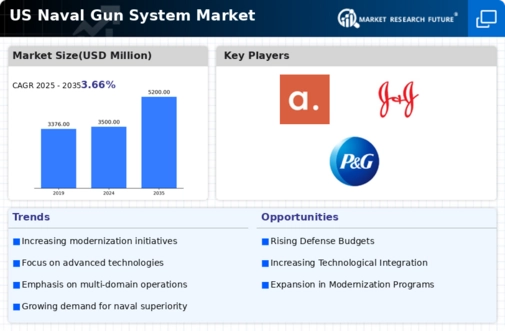Geopolitical Tensions
Geopolitical tensions in various regions are significantly influencing the naval gun-system market in the US. The ongoing conflicts and territorial disputes have prompted the US Navy to enhance its operational readiness, leading to increased demand for advanced naval gun systems. The need for effective maritime defense mechanisms is underscored by the rising threats from adversarial nations, which may lead to a projected growth of around 7% in the naval gun-system market over the next five years. This environment of uncertainty compels the US to invest in robust naval capabilities, ensuring that its fleets are equipped with the latest technology to address emerging threats. Consequently, the naval gun-system market is poised for substantial growth as the US prioritizes its defense strategies.
Rising Defense Budgets
The naval gun-system market in the US is experiencing a notable boost due to increasing defense budgets. The US government has allocated substantial funds to modernize its naval capabilities, with a projected increase of approximately 5% in defense spending over the next few years. This financial commitment is likely to enhance the procurement of advanced naval gun systems, which are essential for maintaining maritime superiority. The emphasis on upgrading existing fleets and acquiring new vessels equipped with state-of-the-art gun systems indicates a robust growth trajectory for the naval gun-system market. Furthermore, the focus on enhancing deterrence capabilities against potential threats is driving investments in advanced weaponry, thereby solidifying the market's expansion in the coming years.
Technological Integration
The integration of cutting-edge technologies into naval gun systems is a pivotal driver for the naval gun-system market in the US. Innovations such as automation, advanced targeting systems, and enhanced fire control technologies are transforming traditional naval artillery into highly efficient and effective weaponry. The market is projected to grow by approximately 6% as these technologies are increasingly adopted. The incorporation of artificial intelligence and data analytics into naval operations is likely to enhance decision-making processes and operational efficiency. As the US Navy seeks to modernize its fleet, the demand for technologically advanced naval gun systems will continue to rise, thereby propelling market growth. This trend indicates a shift towards more sophisticated and capable naval platforms.
Focus on Asymmetric Warfare
The evolving nature of warfare, particularly the emphasis on asymmetric threats, is reshaping the naval gun-system market in the US. As adversaries adopt unconventional tactics, the need for versatile and adaptable naval gun systems becomes paramount. The US Navy is increasingly investing in systems that can effectively counter these threats, which may lead to a market growth of around 5% in the coming years. This focus on flexibility and adaptability in naval operations necessitates the development of advanced gun systems capable of engaging a variety of targets. The naval gun-system market is thus likely to benefit from this strategic shift, as the US seeks to enhance its operational capabilities in diverse combat scenarios.
Environmental Regulations and Sustainability
The naval gun-system market in the US is also influenced by growing environmental regulations and a push for sustainability. As the military seeks to reduce its environmental footprint, there is a rising demand for naval gun systems that comply with stringent environmental standards. This trend may drive innovation in the development of cleaner and more efficient systems, potentially leading to a market growth of 4% over the next few years. The US Navy is increasingly prioritizing sustainability in its operations, which includes the adoption of technologies that minimize environmental impact. Consequently, the naval gun-system market is likely to evolve, focusing on solutions that align with both operational effectiveness and environmental responsibility.














Leave a Comment